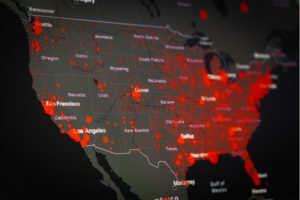Covid-19 is no respecter of ideology—it’s more interested in your immune system. Geography is important, but what we’re really talking about there is population density, which is a very important demographic factor. You would do well to take this into consideration when selecting your Safe Place.
How does your present state rank in regard to coronavirus safety? How about the state you’re considering as your new home? Take a look at the list below giving the coronavirus death rates by state, from low to high. You may be surprised.
U.S. Coronavirus Death Rates
Death rates per 100,000 population, by state and District of Columbia.
Compiled by Reuters, as of September 16, 2020
| Alaska | 6 |
| Hawaii | 7 |
| Wyoming | 8 |
| Vermont | 9 |
| Maine | 10 |
| Oregon | 12 |
| Montana | 13 |
| Utah | 14 |
| West Virginia | 16 |
| Kansas | 18 |
| South Dakota | 21 |
| Wisconsin | 21 |
| Nebraska | 23 |
| North Dakota | 23 |
| Oklahoma | 23 |
| Idaho | 24 |
| Kentucky | 24 |
| Washington | 26 |
| Missouri | 29 |
| North Carolina | 30 |
| Tennessee | 31 |
| New Hampshire | 32 |
| Arkansas | 33 |
| Virginia | 33 |
| Colorado | 35 |
| Minnesota | 35 |
| California | 37 |
| Iowa | 39 |
| Ohio | 39 |
| New Mexico | 40 |
| Nevada | 48 |
| Alabama | 49 |
| Indiana | 51 |
| Texas | 51 |
| Florida | 60 |
| Georgia | 60 |
| South Carolina | 60 |
| Pennsylvania | 62 |
| Delaware | 63 |
| Maryland | 64 |
| Illinois | 68 |
| Michigan | 69 |
| Arizona | 73 |
| District of Columbia | 87 |
| Mississippi | 92 |
| Rhode Island | 102 |
| Louisiana | 114 |
| Connecticut | 126 |
| Massachusetts | 134 |
| New York | 168 |
| New Jersey | 181 |
First, the big caveat: All coronavirus statistics are suspect, as I’ve demonstrated in my pandemic articles for this website. There is no consistent “science” in how the statistics are defined and compiled. Corona “cases” is the most bogus statistic—that depends on the amount of testing, which varies widely, and the tests themselves are notoriously inaccurate. The most reliable statistic is of corona deaths, though even that statistic is not a gold standard—these numbers are often inflated by including people who would have died anyway, without the pandemic, because of serious immune deficiencies.
Still, deaths are the most reliable statistic we have, so let’s go with that. And the only fair and reasonable comparison is deaths per 100,000 population, which puts high-population and low-population localities on an equal footing.
So, what can we learn from this state listing of coronavirus death rates per 100,000 population? This is open to interpretation, so have a go at it yourself. Here are some of my observations. I like to pay special attention to the 10 lowest-death states and the 10 highest-death states because that comparison of the two extremes clarifies a lot of issues.
Population Density
I mentioned at the beginning that population density is a very important demographic factor. You can see that almost all of the lowest-death states are basically rural and low-density. That’s true even with the states among these 10 that have the higher overall populations. Oregon (outside of Portland), Hawaii (outside of Honolulu), Utah (outside of Salt Lake City), and Kansas (outside of Kansas City) are quite rural in their overall character. And their “big cities” don’t compare in size to what you find in California, Texas, and New York.
Now take a look at the highest-death states. Almost all of them are also high-density, and they are joined by the high-density District of Columbia. Mississippi, Louisiana, and Arizona are the only ones that strike me as rural in character, and even there Arizona is dominated by the huge Phoenix metropolitan area and Louisiana by New Orleans. Poverty, contributing to massive immune deficiencies in the population, no doubt accounts for Mississippi’s inclusion among these states.
Conservative vs. Liberal
My first sentence in this report said: “Covid-19 is no respecter of ideology.” Nevertheless, the ideological composition of the lowest-death states compared to the highest-death states is significant.
In large measure, this is because liberals are concentrated in the states with the highest overall populations and highest densities, while conservatives are concentrated in the Heartland areas with the lowest overall populations and lowest densities. But this suggests that, if you wish, you can “have your cake and eat it too,” by picking a state that has a low pandemic death rate, is low in population density—and is politically and culturally conservative. That sounds like a winning formula for a Safe Place to me.
Of the 10 lowest-death states, I count six as conservative and four as liberal—and even Maine may switch to the conservative side in the upcoming election.
Of the 10 highest-death states, I count seven (joined by the District of Columbia, of course) as liberal, and three as conservative.
Bottom line:
Of the 10 lowest-death states: 6 or 7 are conservative, 4 or 3 are liberal.
Of the 10 highest-death states: 7 are liberal and 3 are conservative.
See here for my previous Safe Places articles.





